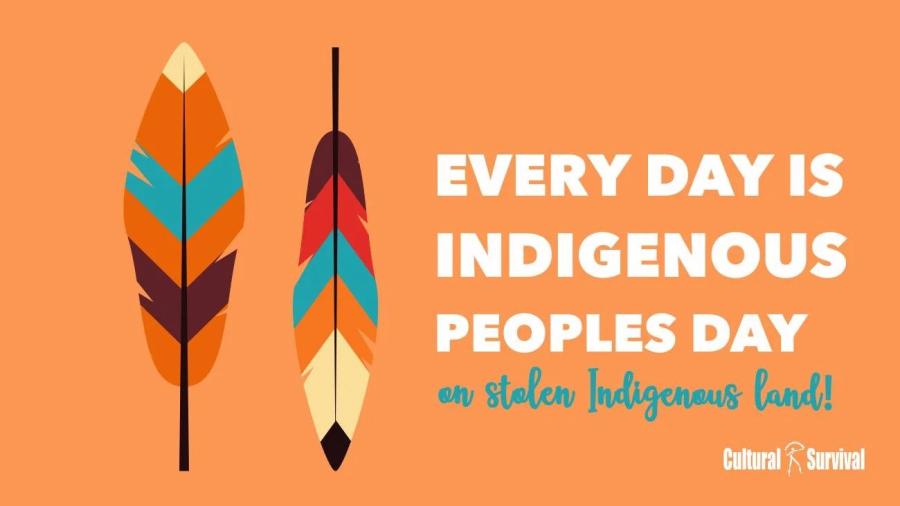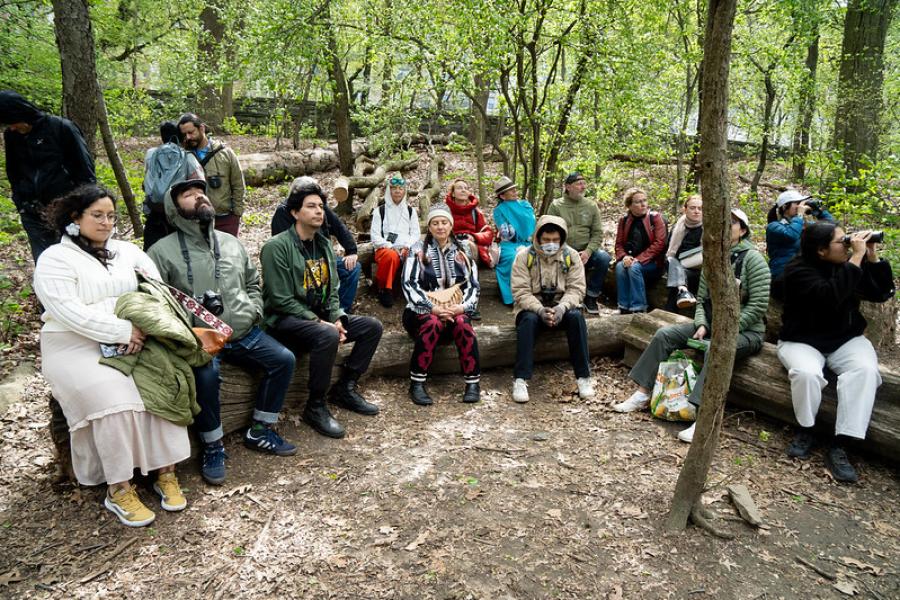How would it feel to be the last speaker of your language on earth? Most English speakers could scarcely imagine the possibility: Marie Smith, the last Eyak Indian of Cordova, Alaska, explained how she felt at being the only full-blooded Eyak and the only remaining speaker of her language: "I don't know why it's me, why I'm the one. I tell you, it hurts. It really hurts.... My father was the last Eyak chief, and I've taken his place. I'm the chief now, and I have to go down to Cordova to try to stop the clear-cutting on our land." (Davidson, 1993)
Like many indigenous people, Marie Smith has a heavy burden to bear. She is engaged in a struggle to defend the ecological integrity of her homeland from outsiders who want to exploit its natural resources. It is a battle not just about the land, but about life and death. At stake is the right of a people to survive and to maintain their distinctive cultural and linguistic identity.
It is no accident that Marie Smith is involved in an ecological as well as a linguistic struggle. The greatest linguistic diversity is found in some of the ecosystems richest in biodiversity. These regions are inhabited by indigenous peoples, who represent around 4 percent of the world's population, but speak at least 60 percent of its 6,000 or more languages. For centuries, individual communities relied on traditional knowledge -- much of it encoded in distinctive ways in their languages passed down orally for generations -- and carried out resource management at local levels. Cultural, linguistic and biological diversity are related, and often inseparable, connected through co-evolution in specific habitats. Where there are indigenous peoples with a homeland, there are still biologically rich environments.(1) However, the dangers facing these small communities are greater than ever. Increasing numbers of languages die each year, as indigenous peoples are assimilated into larger nation-states (some of which are actively seeking to exterminate them), and as their homelands are being destroyed.
Where people have lost their traditional authority over their land or have been forced from it, large scale transformations of the environment have occurred, accompanied by cultural and linguistic decimation. The Penan people of northeast Sarawak are nowadays lucky to find a monkey to eat because the loggers have scared them away; tracks and bulldozers have muddied the waters, and poisons in the bark of fallen trees have killed the fish. Like the once-thriving forests in which they lived, the Penan, too, are disappearing. In 1970, there were 13,000; two decades later, there were fewer than 500. Soon there could be none.
Why Language Loss Matters
People can survive without knowledge of their traditional languages. As long as the peoples themselves survive, why does it matter if Eyak and many hundreds of other languages die? There are at least three strong arguments in favor of preserving linguistic diversity. The first is that the survival of the fittest principle does not apply to languages. The second is that the world's many languages encode critical knowledge of use in areas such as land management, marine technology, plant cultivation, and animal husbandry. Finally, linguistic diversity is an irreplaceable resource for future generations.
Survival of the Fittest Does Not Apply to Languages
Indigenous languages and cultures have often been dismissed as primitive, backward-looking, and in need of replacement. When we examine more closely the process which has led to the dominance of English and a few other world languages, however, we see that it is not a result of any intrinsic deficiency of indigenous languages. Unequal rates of social change have resulted in striking disparities in resources between developed and developing societies; these have been converted into political domination. This imbalance has allowed a few metropolitan groups a virtual stranglehold on global resources and global power.
This power takes many forms, among them the control of the flow of information through radio, television and the Internet. Democracy is severely limited where people cannot use their own languages. Unless people have access to information, they will be controlled by an elite minority that speaks the dominant language, and in most cases, it will be a metropolitan, European one. Ethnicity also grows stronger when actively denied or suppressed. The recent war in Serbia has shown us that when a large portion of the population is denied forms of self-expression, the nation's political and social foundations are weakened.
Although the modern world-economy will require many more people to use English and other global languages, this does not mean that people have to lose their mother tongues if they choose not to do so. Bilingualism is not something mysterious, abnormal, or unpatriotic; rather, it has been an unremarkable necessity for most of human history. Most pre-industrial communities were routine users of several languages. Far from being a divisive force that weakens the bonds of nationhood and political identity, cultural and linguistic pluralism can be a powerful source of new humanity within a world of diversity.
Languages and Critical Knowledge
The next great steps in scientific development may lie locked up in an obscure language in a distant rainforest or on a remote island. Consider a Palauan fisherman bum in 1894. He had names for more than 300 different species of fish and knew the lunar spawning cycles of several times as many species of fish as have been described in scientific literature. (Johannes, 1981) Today's typical youngster in Koror, Palau's capital, cannot identify most of Palau's native fish; nor can his father. The loss of this knowledge has gone hand in hand with over-fishing and degradation of the marine environment.
Languages, like species, are highly adapted to their environments. Some of the detailed knowledge of the natural environment, encoded in human languages spoken by small groups who have lived for centuries in close contact with their surroundings, may provide useful insights into management of resources on which we all depend. The disappearance of hundreds of species of fish, birds, and other forms of life, along with their names and related knowledge of their habitat and behavior, represents an enormous loss to science at precisely the time when we most urgently need to manage local ecosystems more effectively.
Linguistic Diversity is Irreplaceable
Of the many similarities between threatened languages, endangered species, and diverse ecosystems, the most obvious is their irreplaceability. While one technology may be substituted for another, this is not true of languages. To remove one language such as Eyak from the mix of existing languages is to remove it from the world forever. Allowing languages and cultures to die reduces the sum total of our knowledge about the world; just as the extinction of any species entails sacrificing some unique part of the environment, the death of a language removes one of the voices articulating its richness and variety.
Moreover, every group has a right to use its own language, to preserve it as a cultural resource, and to transmit it to its children. Often, the circumstances surrounding language death involve flagrant abuses of human rights. The extinction of the Ubykh language was the final result of a genocide of the Ubykh people, who until 1864 lived along the eastern shore of the Black Sea in the area of Sachi (northwest of Abkhazia). The entire Ubykh population left its homeland when Russia conquered the Muslim northern Caucasus in the 1860s. Thousands of people were expelled and had to flee, no doubt with heavy loss of life, and the survivors were scattered over Turkey. Russian conquest of the Caucasus continues to this day, threatening the lives, lifestyles, and languages of people such as the Chechens.
Because a large part of any language is culture-specific, people feel that an important part of their traditional culture and identity is lost when their language disappears. Globalization on an unprecedented scale does not change the fact that most people everywhere still live their lives in local settings and feel the need to develop and express local identities to pass on to their children. As one Native American, Darryl Babe Wilson, put it, "We must know the white [man's] language to survive in this world. But we must know our language to survive forever." (Hinton, 1994)
Planning for Survival
Since the historical causes of the threats facing the earth's languages, cultures, and biodiversity are similar, the solution is likely to be similar: the empowering of local people. In order to bring about a healthier ecosystem based on a multicultural and multilingual heritage, advocates of linguistic and cultural diversity need to be engaged in a much wider struggle for this empowerment, a guiding principle of the 21(st) century.
The idea that linguistic diversity should be preserved is not a sentimental clinging to some idealized past, but part of the promotion of sustainable, appropriate, empowering development. Good development involves local community involvement, control, and accountability. It is not about setting indigenous peoples aside in isolated reservations, nor is it about expecting them to stay completely unchanged. It is merely about giving them real choice concerning what happens in their territories.
We must get away from seeing modernity and continuity as mutually exclusive. Just as pickup trucks, jeans, and pop music are not inherently incompatible with cultural continuity and indigenous identity, speaking English need not be at odds with speaking Eyak or Navajo. The active cultivation of multilingualism can provide a harmonious pathway through the clash of values inherent in today's struggle between the global and local, between uniformity and diversity.
Indigenous peoples should be considered essential allies -- and not obstacles -- in the struggle for conservation. Recent encouraging alliances between indigenous peoples and environmentalists, based on indigenous management or co-management, have led to new kinds of protected areas. Australia's Kakadu and Uluru-Kata Tjuta national parks are good examples of protected area co-management where conservation priorities are integrated with the cultural and linguistic survival goals of indigenous people. The government's lease of the land safeguards aboriginal ownership through legal recognition of title, and it provides funding for conservation as well as opportunities for local training and employment. Significant Aboriginal input into management and decision-making is crucial; Aboriginal people retain the majority of seats on management boards and conduct meetings in Aboriginal languages such as Pitjantjatjara.(2)
Ideally, however, such protected areas should be proposed, planned, established, and maintained by indigenous peoples, with recognition and support by governments and international agencies.
Although we may survive the loss of most of the world's languages and cultures, the result will be a seriously reduced quality of life, and for some people, the loss of the very meaning of life itself. With the passing of each voice, we lose a little more of who we were and are, and of what we may become. A varied natural system is inherently more stable than a monoculture. We should also preserve our linguistic diversity for moral, ethical, and aesthetic reasons. Variety is not just the proverbial spice of life, it is a prerequisite for life.
(1). This principle is known as the Rule of Indigenous Environments, proposed by Bernard Nietschmann (1992). The story is told in more detail by Diamond (1997).
(2). These and other alliances between indigenous peoples and environmentalists are discussed in Stevens (1997).
References & further reading
Davidson, A. (1993). Endangered Peoples. San Francisco: Sierra Club Books.
Diamond, J. (1997) Guns, Germs and Steel: The Fates of Human Societies. New York: Norton.
Hinton, L. (1994). Flutes of Fire: Essays on Californian Indian Languages. Berkeley: Heyday Books.
Johannes, R.E. (1981). Words of the Lagoon: Fishing and Marine Lore in the Palau District of Micronesia. Berkeley: University of California Press.
Nietschmann, B. (1992). The interdependence of biological and cultural diversity. In Center for World Indigenous Studies Occasional Paper No. 21. Pp 3.
Stevens, S., Ed. (1997). Conservation Through Cultural Survival: Indigenous Peoples and Protected Areas. Washington, DC and Covelo, CA: Island Press.
Article copyright Cultural Survival, Inc.



